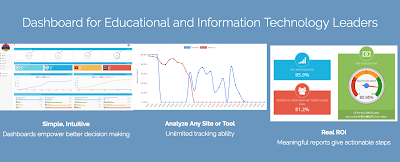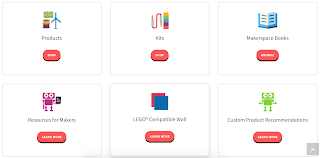Well, that title most certainly lacks the fervor of a Saturday Night Live opener, but I mean it with just as much gusto! Welcome to Chicago and your virtual glimpse into the highlights of my ISTE 2018 experience. The International Society for Technology in Education is a tremendous conference that obviously takes substantial planning, effort, and follow-through. I am continually impressed with the lengths the ISTE leadership goes through to ensure a flawless conference filled with learning, collaboration, and inspiration.
 From the moment you enter McCormick Place, the learning begins. Sessions, Playgrounds, Keynotes, Poster Sessions, and more surround you. From then on, it is like drinking from a fire hose. Fast and furiously, you begin taking notes and processing copious amounts of information, stuffing it into small open pockets of memory. I have come away with more this year than ever before, in large part because I really learned how to play the ISTE game. (More on that later.) For now, I’ll share some of the most significant game-changers from ISTE 2018.
From the moment you enter McCormick Place, the learning begins. Sessions, Playgrounds, Keynotes, Poster Sessions, and more surround you. From then on, it is like drinking from a fire hose. Fast and furiously, you begin taking notes and processing copious amounts of information, stuffing it into small open pockets of memory. I have come away with more this year than ever before, in large part because I really learned how to play the ISTE game. (More on that later.) For now, I’ll share some of the most significant game-changers from ISTE 2018.
1. Start-Ups. These are always interesting, as the excitement, energy, and hopefulness are palpable as you speak with the representatives. While there were several that seemed incredibly impressive, I was particularly intrigued by one: Paper Basket.
 This start-up has one simple, albeit important goal: to provide districts with analytics related to the active use of devices and the sites/programs being utilized within the district. I stress ‘active’, because many sites out there claim to analyze the use of programs, but fail to address the cunning maneuvers of teens who simply minimize those programs they should be working on while, instead, choosing to peruse YouTube for the next Bieb. If you’re in education, you know exactly the type of Internet trickery they pull. Paper Basket knows this and only gives active use credit to the one program running at the forefront. Pricing is district-wide, based on student population, and is affordable considering the amount of money one can save in unused subscription prices in any given year. It will definitely help districts decide how better to spend their money and give hard data justification for future spending. It’s most definitely worth checking out if you’re a school wondering if you’re getting bang for your buck on your technology purchases. Frankly, what responsible district isn’t? The caveat … it doesn’t work for iOS devices, because Apple. They currently don’t allow for these types of analytics on their devices, with anyone. Yet. I’m hopeful this will change, but it will certainly serve us well for the Mac OS we use with the majority of our students.
This start-up has one simple, albeit important goal: to provide districts with analytics related to the active use of devices and the sites/programs being utilized within the district. I stress ‘active’, because many sites out there claim to analyze the use of programs, but fail to address the cunning maneuvers of teens who simply minimize those programs they should be working on while, instead, choosing to peruse YouTube for the next Bieb. If you’re in education, you know exactly the type of Internet trickery they pull. Paper Basket knows this and only gives active use credit to the one program running at the forefront. Pricing is district-wide, based on student population, and is affordable considering the amount of money one can save in unused subscription prices in any given year. It will definitely help districts decide how better to spend their money and give hard data justification for future spending. It’s most definitely worth checking out if you’re a school wondering if you’re getting bang for your buck on your technology purchases. Frankly, what responsible district isn’t? The caveat … it doesn’t work for iOS devices, because Apple. They currently don’t allow for these types of analytics on their devices, with anyone. Yet. I’m hopeful this will change, but it will certainly serve us well for the Mac OS we use with the majority of our students.
2. Flexible Seating. While cool chairs and wheelie tables are certainly nothing new, the Future Ready Schools movement and Mackin’s TYSL (Transform Your School Library) have really helped to spark the need to bring today’s libraries up to snuff with meeting the needs of today’s learner. No longer is a library a place to be shushed by a stern-faced librarian with stringed readers perched at the tip of her nose. It is a place of digital collaboration, making, exploration, and research. Media specialists have a very unique job of instilling a love of reading as well as an awareness of digital citizenship responsibilities. To entertain all of the facets of this new role, flexible seating is a must. We need to accommodate all groups of learners, from those who are functioning independently to those groups who wish to collaborate on a project. The types of flexible seating options are incredibly plentiful. Like a toddler in a tiara, the time frame to act is precious and short. I was impressed by the options at ISTE. Steelcase and Mooreco were leaders, in my opinion, providing impressive options for today’s library spaces.
 3. Makerspaces and the like. Personally, I don’t like the word ‘Makerspaces’. Duh. Isn’t anyone who is creating something new ‘making’? Does it really need to be in a certain space? I realize this is somewhat petty and particular, but I want to encourage the fact that it is more of a laboratory. A place to experiment and TRY. Regardless of my semantic preference, items that fit into this category are plentiful and there was no shortage of vendors and sessions dedicated to the topic. From a plethora of digital options to hosts of “analog” items, I was left with more choices for this area than I could hope to use in a lifetime. MackinMaker was of particular interest to me, as their pre-vetted collections designed for each grade span take the guesswork out of getting started. In this way, companies like Little Bits and Sphero showcased their products independently, as well, highlighting the possibilities and updates to their lineup of devices. Looking to get started with your space? Mackin’s Heather Lister is an incredible resource for guidance in this area. Reach her on Twitter: @heathermlister to start your conversation.
3. Makerspaces and the like. Personally, I don’t like the word ‘Makerspaces’. Duh. Isn’t anyone who is creating something new ‘making’? Does it really need to be in a certain space? I realize this is somewhat petty and particular, but I want to encourage the fact that it is more of a laboratory. A place to experiment and TRY. Regardless of my semantic preference, items that fit into this category are plentiful and there was no shortage of vendors and sessions dedicated to the topic. From a plethora of digital options to hosts of “analog” items, I was left with more choices for this area than I could hope to use in a lifetime. MackinMaker was of particular interest to me, as their pre-vetted collections designed for each grade span take the guesswork out of getting started. In this way, companies like Little Bits and Sphero showcased their products independently, as well, highlighting the possibilities and updates to their lineup of devices. Looking to get started with your space? Mackin’s Heather Lister is an incredible resource for guidance in this area. Reach her on Twitter: @heathermlister to start your conversation.

4. Last, but certainly not least, is the release of ISTE’s new lineup of standards and tools to help the leaders in every district. ISTE Standards for Leaders was released during this conference, and I have to say that they are much needed and incredible. You can find a link to them here. These 5 standards differ from that of the student and educator in the fact that there is much more of an umbrella focus on vision, designing, and advocacy. ISTE recognized the need for those of us trying to lead the charge to have a well-defined set of goals for guiding districts. Also of particular interest are the Digital Learning Pathways which provide resources for those empowering others through the use of technology. Lesson plans, scenarios, and guides are all provided and allow for seamless scaffolding and collaboration.
Honestly, I could go on and on. But those I will save for another day. Take these four and run. Gather your thoughts with the goal of implementing the 3E’s: Engage, Enhance, and Extend as it relates to student learning. This is how I play the ISTE game. By going in with these overarching concepts in mind, everything I learn fits into at least one of these areas. Categorizing them helps me to see where I will best be able to utilize them upon return. Too often people show up at conferences, gather a bunch of random information, and do nothing with it in the end. This isn’t because of lack of effort or care. It’s just because it is too much of a muddled mess. Go in looking to fill your categories. Whether it’s SAMR, TPACK, or another pedagogical way of thinking, fill your cup with knowledge in these areas. It will give your session selections focus and obvious purpose. It will make the implementation that much easier and more effective. Your students need opportunities not possible without technology. Challenge them. Challenge yourself. Learn together. There is truly no greater way.






